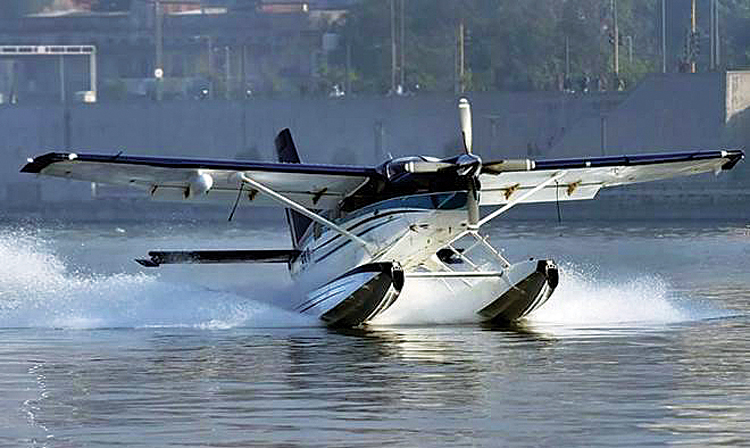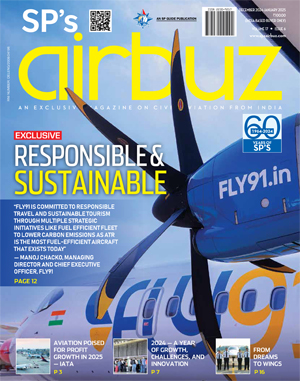Future of Seaplane Services in India
Whether India will figure as a major operator of seaplane services, will finally depend on the determination with which the government handles this segment of the civil aviation industry

The much awaited and the very first water taxi service in India that has been commissioned and made operational on February 17 this year, is designed to connect the East Coast of Mumbai with mainland in Navi Mumbai and other locations. This facility was inaugurated by Uddhav Thackeray, the Chief Minister of Maharashtra, in the presence of Sarbananda Sonowal, the Minister for Shipping of the central government. Also present to witness the event were Ajit Pawar, the Deputy Chief Minister of Maharashtra and a number of other dignitaries. The agencies that worked on this project and successfully brought it to fruition were the Mumbai Port Trust, Maharashtra Maritime Board as well as the City and Industrial Development Corporation.
It is for the first time that Mumbai and Navi Mumbai will be connected by a maritime public transport service that is fast and reliable. This facility will help in reducing significantly the travel time between these two locations. As stated by the Chief Minister Uddhav Thackeray during the inaugural ceremony, the city of Mumbai always sets a trend that is soon emulated by the rest of the country. In fact, the country’s first railway service between Mumbai’s Bori Bunder station and Thane that was that was launched by the British government in India on April 16, 1953, spread all over the country in a very short period of time.
The concept of using a boat as a water taxi is believed to have evolved from the traditional use of gondolas as a mode of public transport in Europe over five hundred years ago. The earliest operation of water taxi service on record was in Manchester in England. In the 1990s, water taxi service became much more popular especially in the canals of Venice. Over the years, gondolas that were a major means of transportation, were progressively replaced by boats that were relatively smaller in size as compared to the gondolas.
Commissioning of a water taxi service will undoubtedly provide the people of Mumbai considerable relief as travelling by road in the city of Mumbai has become increasingly tedious on account the rapid increase in the density of road traffic. The problem of traffic congestion and related woes have been further aggravated by the fact that the suburban train network in Mumbai is already heavily congested and there is no room for any further enhancement of capacity. Under these circumstances, the water taxi service will certainly help in easing the ever increasing woes of travel for the public.
As India has a vast coastline as also a number of island territories in the Indian Ocean Region, there is certainly much scope for the development of water taxi service on a wide scale. However, there is another segment in the transportation industry that offers immense scope for the development is the seaplane service. While there has been some development in India in this segment of the transportation industry, it has unfortunately not received the attention of the government to the extent that it should have. The first attempt to venture into this field was made just over a decade ago on December 30, 2010 with the launch by way of a pilot project of a commercial seaplane service based in the Andaman and Nicobar Islands. This service that was inaugurated by the then Indian Civil Aviation Minister, Praful Patel, was named as Jal Hans and at the time of its launch, the aircraft deployed had a capability of carrying only ten passengers.
The State of Gujarat launched its first seaplane service on October 31, 2020, the birth anniversary of Sardar Vallabhbhai Patel. The seaplane service that was named as Spice Shuttle, was operated by the popular Indian carrier SpiceJet and was intended to connect Kevadia in Narmada district, the home to the world’s tallest statue, the Statue of Unity, to the Sabarmati River Front in Ahmedabad. The seaplane deployed had a capacity of carrying 14 passengers and the daily passenger traffic was around 200. Unfortunately, on account of a number of problems including COVID-19, seaplane services have remained suspended. Hopefully, operation of seaplane services in Gujarat will be resumed in the near future.
Today, seaplane services are being operated by multiple airlines in a number of countries across the world such as the Philippines, Canada, Australia, the United States, Finland, the United Kingdom, Sri Lanka, Fiji, New Zealand, Papua New Guinea, United Arab Emirates, Italy, Maldives and Hong Kong. Whether or not India will figure as one of the major operators of seaplane services, will finally depend on the drive and determination with which the government handles this segment of the civil aviation industry.





